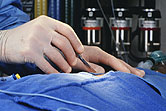- See What Saffron Can Do for Sleep and Heart Health
- 6 Common Mistakes to Avoid Before Your Physical
- Can Sweating Really Help You Beat a Cold?
- Strengthening Your Relationship: Practical Strategies
- Skip Storing This Everyday Product in the Fridge Door
- Green Tea + B3 Pairing May Boost Brain Health
- Navigating Your Midlife Crisis: Embracing New Possibilities
- City Raccoons Showing Signs of Domestication
- Mapping the Exposome: Science Broadens Focus to Environmental Disease Triggers
- One Week Less on Social Media Linked to Better Mental Health
Stem Cells From Fat Might Improve Plastic Surgery


THURSDAY, Sept. 26Using people’s own stem cells from their body fat could aid in plastic surgery procedures such as post-cancer breast reconstruction, a small, preliminary study suggests.
The study, published in the Sept. 28 issue of The Lancet, looked at whether stem cells might improve the current technique of “lipofilling” — where fat is removed via liposuction from one part of the body, purified, then injected into another area of the body.
Doctors use lipofilling in cosmetic procedures to create smoother skin or fuller lips. But it also has a range of medical uses. Fat injections can help reshape the breasts in women having reconstruction after breast cancer surgery. They can also be used in correcting facial deformities caused by an injury or congenital defect, or helping certain burn injuries heal.
The problem is that transferred fat often doesn’t last, explained lead researcher Dr. Stig-Frederik Kolle.
“It’s unpredictable,” said Kolle, of the plastic surgery department at Copenhagen University Hospital in Denmark. “And you often have to repeat the procedure to get a [satisfactory] result.”
So Kolle’s team tested a different approach: Take stem cells from people’s body fat and use them to “enrich” the fat tissue being transplanted from one body area to another. Stem cells are primitive cells that develop into more mature ones.
The researchers recruited 10 healthy volunteers who underwent liposuction to have fat taken from the abdomen. The fat was then purified and injected into the volunteers’ upper arms. In one arm, the fat transplant was enriched with stem cells; the other arm received a traditional transplant.
After about four months, the researchers took MRI images of the fat transplants, then removed them. It turned out that the stem cell-enriched transplants had retained about 81 percent of their initial volume, on average — compared with only 16 percent among the stem cell-free transplants.
Dr. J. Peter Rubin, chair of plastic surgery at the University of Pittsburgh Medical Center, said the study is “very” important.
“We’ve known that this works in animals. What’s been missing is good data on humans,” said Rubin, co-author of an editorial accompanying the study.
These early results offer a “proof of principle,” and need to be followed up with clinical trials of actual patients, rather than healthy volunteers, Rubin said.
One question is whether the transplanted fat will hold up over the long term, experts say. “We have no reason to believe that it won’t last,” Kolle said, but it still needs to be shown in studies.
And why do the added stem cells help? It’s not clear, said Kolle. One possibility is that they spur the growth of small blood vessels and give the transplanted fat a better blood supply. The stem cells may also develop into mature fat cells, or send out “signals” that cause other cells — such as fat or blood vessel cells — to increase in number.
As for safety, Kolle and Rubin said there is a theoretical concern in using stem cell-enriched fat in women who’ve been treated for breast cancer. Some of the benefits of stem cells — such as releasing “growth factors” that stimulate other cells — could potentially feed a breast cancer recurrence.
“There’s no evidence to suggest that this is true,” Rubin said. But it is a possibility that everyone should be aware of, he added.
Kolle agreed. “We need to move forward carefully,” he said.
Even if stem cell-enriched fat transplants prove safe and long lasting, there will be practical hurdles, since the approach would add costs and complexity. Kolle said the process of harvesting the stem cells, then growing and expanding them in cultures, is actually relatively simple — but the facilities have to be in place.
“No, not every center will be able to do this,” he said.
Still, editorial author Rubin said that new technology is needed. Breast reconstruction, he noted, has been done by the same methods for decades. It’s possible, said Rubin, that stem cells could help allow some women to have reconstruction done solely via fat injections — without the major surgery or implants used now.
The current study was funded by the Danish Cancer Society. None of the researchers reports any financial conflicts of interest. Rubin has submitted a patent application for an instrument that harvests body-fat tissue.
More information
Breastcancer.org has more on fat grafting and breast reconstruction.
Source: HealthDay
Copyright © 2025 HealthDay. All rights reserved.










